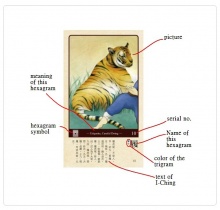This deck of I-Ching cards is designed to make learning I-Ching and the Chinese fortune-telling easy and fun having.
It is an artwork by Ryoka, a young artist in Tainan, Taiwan .
Jack, the founder of eee-Learning.com website had a master degree in Philosophy from Tunghai Universiy. He has been studying I-Ching since more than 20 years ago. Ryoka is a young artist who has majored in visual communication design during her study and is currently working at a publishing house as a fine art designer. Three years ago when Ryoka just got graduated from college Jack met her. They began the design work of this deck. Jack told Ryoka the meaning of each hexagram, and Ryoka visualized the principle or allusion to present the hidden meanings in the hexagrams.
I-Ching (易經) , or Chang of Book, we name it as EEE Book, is an ancient master piece that originated in Zou or Shang Dynasty. Basically it is a fortune-telling tool book that was evolved from the oracle bone script. But it is not just a fortune-telling book, it is also an abundant resource of ancient philosophy and history. That's why it is the most important text book of Confucianism for thousands of years.
The content of I-Ching is all about the 64 "gua" (卦). Every gua has 6 lines, so we call a "gua" as "hexagram" in English. Each line we call it "yau"(爻), it could be "-" or "- -" . "-" symbols yang(陽) means positive, maskulin, dynamic and "- -" is yin(陰) means negative, ferminine, static. The oracle of each hexagram may be interpreted by the relationship of the yin-yang combinations of the 6 lines, or read the predictive text in I-Ching directly. Because the author of I-Ching used fable or legend story to interpret the oracle. We can learn the hexagram by the ancient story in the text of I-Ching, in addition reading the yin-yang interactive in the 6 lines.
Each card of this deck is designed to illustrate the stories in the text or the yin-yang interaction principle. You can easily understand what the hexagram says by reading the art picture.
For example, hexagram 3 means big challenge before your action or initiative. Hexagram 10 is a story about a man met a tiger on the road , and how will he survive to pass by the beast. Hexagram 34 is a story about an angry goat that was trapped. Hexagram 64 is about a fox that sought for water in drought and was almost drowned in a pool.
This deck contains 66 cards, 2 "white cards" and 64 hexagram cards.
White cards
There are two "white card" in this deck. One is the 8(trigrams) x 8(trigrams) table for the 64 hexagrams, another is the pithy formula for the 8x8 table.
This two cards have two functions:
- help the beginner to recite 64 hexagrams。
- redundance:if you lost one or two cards, you can use these two card as substitutes。
64 hexagram cards
 Each card provides basic informations for the hexagram includes:
Each card provides basic informations for the hexagram includes:
The Picture: This is the major element of every card. Every picture is designed to tell the story or principle of the hexagram. If you understand the picture , and you can read and interprate the meaning of the hexagram.
The text:The Chinese text of I-Ching.
Series No. : Each hexagram has its unique serial No.
The English meaning: The simplest way to read and understand the hexagram.
Color of trigram: A design that allows you to use this deck to get the foretune-telling result equivalence to the ancient Da Yan method.
- Log in to post comments



































































